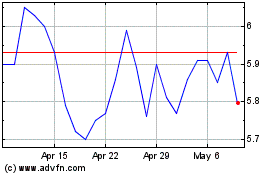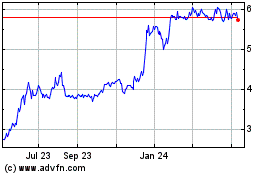NGL Energy Partners LP (NYSE: NGL) (the “Partnership” or “NGL”)
announced today that the Board of Directors of its general partner
declared a quarterly distribution of $0.39 per unit, or $1.56 per
unit on an annualized basis, for the quarter ended March 31, 2017.
This cash distribution is payable on May 15, 2017 to common
unitholders of record at the close of business on May 8, 2017.
Additionally, the Board of Directors declared a distribution for
the quarter ended March 31, 2017 to be paid to the holders of the
Class A Preferred Units according to the terms outlined in NGL's
Partnership Agreement. The Class A Preferred distribution will also
be paid on May 15, 2017.
In April 2016, the Board of Directors of NGL’s general partner
made the decision to reduce the distribution by 39% in order to
focus on strengthening the balance sheet, which included foregoing
approximately $64 million of annual general partner distributions.
Since that time, NGL has successfully increased liquidity and
executed several growth initiatives while targeting distribution
coverage in excess of 1.3x. While NGL had anticipated an increase
in distributions commencing this quarter, in light of current
market conditions, particularly fluctuating commodity prices and
their anticipated impact on NGL's results for its quarter ended
March 31, 2017, the Board of Directors has chosen to defer this
increase in distributions for up to an additional three quarters.
Following this deferral, NGL's management anticipates then
recommending to its Board of Directors an increase in the
distribution policy consistent with NGL's previously announced
distribution guidance.
Fiscal Years 2017 and 2018 Guidance
Based upon preliminary financial information, NGL expects fiscal
year 2017 Adjusted EBITDA of approximately $380 million, which
includes an approximately $42 million contribution by the Grand
Mesa Pipeline. These preliminary results were adversely influenced
by the significantly warmer than normal winter resulting in lower
propane volumes and pricing, continued pressure in crude marketing
and transportation, decreased demand for diesel fuel, lower than
expected margins for biodiesel sales and an extended decline in
gasoline line space values on the Colonial Pipeline, all of which
negatively impacted fourth quarter results.
For fiscal year 2018, NGL expects to generate Adjusted EBITDA of
approximately $500 million to $525 million, which includes Adjusted
EBITDA for Grand Mesa Pipeline for 12 months of operations at
approximately $130 million; continued improvement in the water
segment; an anticipated increase in crude production and refined
products demand; and the benefit of a full 12 months of operations
for several of our recent projects and acquisitions, including the
Houma and Port of Point Comfort projects and the Port Hudson and
Kingfisher terminal assets which were acquired from Murphy Energy
in January 2017. NGL's guidance also takes into consideration
management’s lowered expectations for propane volumes, continued
challenges in crude marketing and transportation together with the
impact of lower line space values carrying into fiscal year 2018.
Distributable Cash Flow is expected to be $300-325 million and
could generate over $100 million of excess cash flow, which would
provide at least 1.3x coverage for the year based on the deferral
of the distribution increase. Additional information regarding our
fiscal year 2018 guidance is expected to be provided on NGL’s
earnings call for its fiscal year ended March 31, 2017, which is
expected to be held on Thursday, May 25, 2017.
Non-GAAP Financial Measures
NGL defines EBITDA as net income (loss) attributable to NGL
Energy Partners LP, plus interest expense, income tax expense
(benefit), and depreciation and amortization expense. NGL defines
Adjusted EBITDA as EBITDA excluding net unrealized gains and losses
on derivatives, lower of cost or market adjustments, gains and
losses on disposal or impairment of assets, gain on early
extinguishment of liabilities, revaluation of investments,
equity-based compensation expense, acquisition expense and other.
We also include in Adjusted EBITDA certain inventory valuation
adjustments related to our Refined Products and Renewables segment,
as described below. EBITDA and Adjusted EBITDA should not be
considered alternatives to net income, income before income taxes,
cash flows from operating activities, or any other measure of
financial performance calculated in accordance with GAAP as those
items are used to measure operating performance, liquidity or the
ability to service debt obligations. NGL believes that EBITDA
provides additional information to investors for evaluating NGL’s
ability to make quarterly distributions to NGL’s unitholders and is
presented solely as a supplemental measure. NGL believes that
Adjusted EBITDA provides additional information to investors for
evaluating NGL’s financial performance without regard to NGL’s
financing methods, capital structure and historical cost basis.
Further, EBITDA and Adjusted EBITDA, as NGL defines them, may not
be comparable to EBITDA, Adjusted EBITDA, or similarly titled
measures used by other entities.
Other than for NGL’s Refined Products and Renewables segment,
for purposes of the Adjusted EBITDA calculation, NGL makes a
distinction between realized and unrealized gains and losses on
derivatives. During the period when a derivative contract is open,
NGL records changes in the fair value of the derivative as an
unrealized gain or loss. When a derivative contract matures or is
settled, NGL reverses the previously recorded unrealized gain or
loss and records a realized gain or loss. NGL does not draw such a
distinction between realized and unrealized gains and losses on
derivatives of NGL’s Refined Products and Renewables segment. The
primary hedging strategy of NGL’s Refined Products and Renewables
segment is to hedge against the risk of declines in the value of
inventory over the course of the contract cycle, and many of the
hedges are six months to one year in duration at inception. The
“inventory valuation adjustment” row in the reconciliation table
reflects the difference between the market value of the inventory
of NGL’s Refined Products and Renewables segment at the balance
sheet date and its cost. NGL includes this in Adjusted EBITDA
because the gains and losses associated with derivative contracts
of this segment, which are intended primarily to hedge inventory
holding risk, also affect Adjusted EBITDA.
Distributable Cash Flow is defined as Adjusted EBITDA minus
maintenance capital expenditures and cash interest expense.
Maintenance capital expenditures represent capital expenditures
necessary to maintain the Partnership’s operating capacity.
Distributable Cash Flow is a performance metric used by senior
management to compare cash flows generated by the Partnership
(excluding growth capital expenditures and prior to the
establishment of any retained cash reserves by the Board of
Directors) to the cash distributions expected to be paid to
unitholders. Using this metric, management can quickly compute the
coverage ratio of estimated cash flows to planned cash
distributions. This financial measure also is important to
investors as an indicator of whether the Partnership is generating
cash flow at a level that can sustain, or support an increase in,
quarterly distribution rates. Actual distributions are set by the
Board of Directors of NGL’s general partner.
Forward-Looking Statements
This press release includes “forward-looking statements.” All
statements other than statements of historical facts included or
incorporated herein may constitute forward-looking statements.
Actual results could vary significantly from those expressed or
implied in such statements and are subject to a number of risks and
uncertainties. While NGL believes such forward-looking statements
are reasonable, NGL cannot assure they will prove to be correct.
The forward-looking statements involve risks and uncertainties that
affect operations, financial performance, and other factors as
discussed in filings with the Securities and Exchange Commission.
Other factors that could impact any forward-looking statements are
those risks described in NGL’s annual report on Form 10-K,
quarterly reports on Form 10-Q, and other public filings. You are
urged to carefully review and consider the cautionary statements
and other disclosures made in those filings, specifically those
under the heading “Risk Factors.” NGL undertakes no obligation to
publicly update or revise any forward-looking statements except as
required by law.
About NGL Energy Partners LP
NGL Energy Partners LP is a Delaware limited partnership. NGL
owns and operates a vertically integrated energy business with five
primary businesses: water solutions, crude oil logistics, NGL
logistics, refined products/renewables and retail propane. For
further information, visit the Partnership’s website at
www.nglenergypartners.com.
This release is a qualified notice under Treasury Regulation
Section 1.1446-4(b). Brokers and nominees should treat 100% of NGL
Energy Partners LP’s distributions to foreign investors as being
attributable to income that is effectively connected with a United
States trade or business. Therefore, distributions to foreign
investors are subject to federal income tax withholding at the
highest applicable effective tax rate.
View source
version on businesswire.com: http://www.businesswire.com/news/home/20170424006689/en/
NGL Energy Partners LPTrey Karlovich, 918-481-1119Executive Vice
President and Chief Financial
OfficerTrey.Karlovich@nglep.comorLinda Bridges, 918-481-1119Vice
President – Finance and TreasurerLinda.Bridges@nglep.com
NGL Energy Partners (NYSE:NGL)
Historical Stock Chart
From Mar 2024 to Apr 2024

NGL Energy Partners (NYSE:NGL)
Historical Stock Chart
From Apr 2023 to Apr 2024
